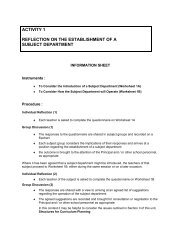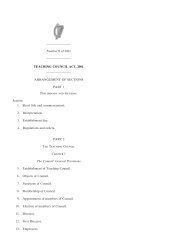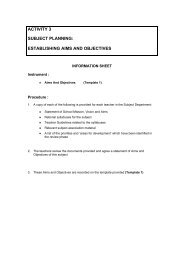Co-Operative School Evaluation Project (File Format PDF 550KB)
Co-Operative School Evaluation Project (File Format PDF 550KB)
Co-Operative School Evaluation Project (File Format PDF 550KB)
You also want an ePaper? Increase the reach of your titles
YUMPU automatically turns print PDFs into web optimized ePapers that Google loves.
COOPERATIVE SCHOOL EVALUATION PROJECT<br />
INSTRUMENTATION<br />
1.2.4 The impact indicator<br />
The IMPACT indicator examines the outcome of the policy or action undertaken. It looks for impact, rather than<br />
activity. The main question here is: Does the policy have the impact that was intended From a planning<br />
perspective, this means that evaluation procedures are built into the planning process to ensure that the policy is<br />
effective. This differs from the monitoring aspect of the implementation phase, which is concerned with information<br />
flow. However, the monitoring aspect of implementation is clearly linked with the overall evaluation of the policy’s<br />
impact.<br />
4. IMPACT This indicator examines the way the policy is evaluated.<br />
4.1 Criteria Criteria have been set to evaluate the effectiveness of the policy.<br />
4.2 Data Data is collected about the impact of the policy.<br />
The data is up-to-date.<br />
4.3 <strong>Evaluation</strong> There is a process for evaluating the impact of the policy.<br />
The evaluators are skilled in this area.<br />
The planning process can respond to the outcomes of the evaluation.<br />
Table 5 Level 2 Sub-Indicators for the Impact Indicator<br />
Three sub-indicators were developed (Table 5). The first looks for evaluation Criteria built into the planning<br />
process. This counters a tendency in evaluation exercises to develop new criteria at the time of evaluation which<br />
may embody a level of rationalisation in the face of problems encountered at implementation.<br />
The second sub-indicator signals the importance of up-to-date Data in the evaluation process.<br />
2. Instrumentation<br />
At the initial international seminar in June 2004, it was decided that a common approach to evaluation in both the<br />
initial trial phase and the main trial phase would be appropriate. This would help clarify issues that might be<br />
pertinent to individual cultures. At that meeting, it was decided that the three participating countries would focus<br />
on the policy of anti-bullying in the initial trial phase. A design brief for the evaluation instruments was prepared<br />
for the Irish Steering <strong>Co</strong>mmittee.<br />
The focus of the indicators was on planning within a school development planning process. Hence, the focus of<br />
instrumentation was on individual schools, rather than on a system level evaluation. In designing instrumentation,<br />
a comprehensive approach to evaluation was used. The aim was to triangulate as much evidence as possible on<br />
planning activities in a school. Therefore, methodologies that produced in-depth information were preferred to<br />
methodologies that gave rise to summary information. As a result, there was a preference for structured interviews<br />
over questionnaires. It was appreciated that at a later stage, once the indicators had been verified, a less intense<br />
approach to data gathering could give rise to valid and reliable evaluations depending on the purpose of the evaluator<br />
in using the indicators.<br />
<strong>Evaluation</strong> instruments for the initial trial were developed taking account of the feedback received at the June<br />
meeting, and in September 2004, the following instruments, with supporting documentation, were circulated to the<br />
participating partners (Table 6). National authorities/agencies had an opportunity to translate the documentation<br />
for use in their own countries during October 2004.<br />
The final sub-indicator examines the process of <strong>Evaluation</strong>. This requires that there is some formal mechanism to<br />
carry out an evaluation and that those who carry out the evaluation are competent to do so. The evaluation process<br />
must also address the organisation’s capacity to respond to the results. This sub-indicator is particularly relevant to<br />
self-evaluation. The engagement of participants in the process may give rise to micro-politics that blocks critical<br />
analysis and underestimates the capacity for change. Similarly, an external evaluation can create tensions between<br />
the criteria used and the local reality of the school.<br />
22<br />
23

















